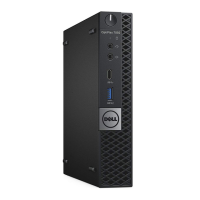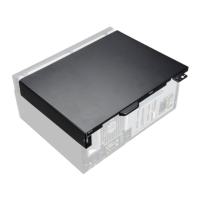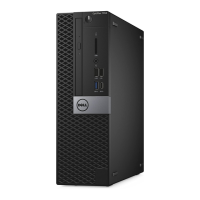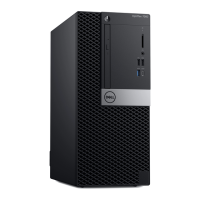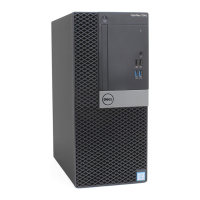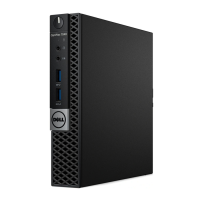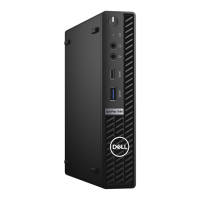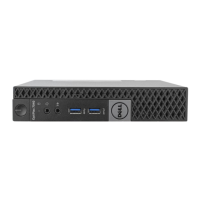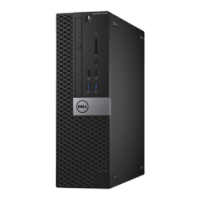Do you have a question about the Dell OptiPlex 7050 and is the answer not in the manual?
Guidelines for safe handling and operation to protect computer and ensure personal safety.
Steps to prepare before accessing internal components for maintenance or upgrades.
Procedures to shut down the computer properly in Windows 10 and Windows 7.
Steps to take after completing internal tasks, including reconnecting devices.
Step-by-step guide to remove a 2.5-inch drive assembly.
Procedures for removing and installing an M.2 PCIe SSD.
Procedures for removing and installing memory modules.
Instructions for removing and installing the computer processor.
Procedures for removing and installing the system board.
Details on Intel 6th and 7th Gen processors used in the system.
How to configure the computer's boot order.
Setting system and BIOS passwords for security.
Procedures for modifying or removing passwords.
Step-by-step instructions for updating the system BIOS.
Guide to downloading drivers from Dell's support site.
Explains meanings of power LED light statuses.
Lists and explains common error messages.
Details specific system error messages and their causes.
| Bus type | DMI3 |
|---|---|
| Stepping | B0 |
| Tjunction | 100 °C |
| Processor cache | 6 MB |
| Processor cores | 4 |
| Processor model | i5-7500 |
| System bus rate | 8 GT/s |
| Processor family | Intel® Core™ i5 |
| Processor series | Intel Core i5-7500 Desktop Series |
| Processor socket | LGA 1151 (Socket H4) |
| Processor codename | Kaby Lake |
| Number of QPI links | 0 |
| Processor frequency | 3.4 GHz |
| Processor cache type | Smart Cache |
| Processor lithography | 14 nm |
| Processor manufacturer | Intel |
| PCI Express slots version | 3.0 |
| Processor boost frequency | 3.8 GHz |
| Processor operating modes | 64-bit |
| ECC supported by processor | No |
| PCI Express configurations | 1x16, 1x8+2x4, 2x8 |
| Thermal Design Power (TDP) | 65 W |
| Number of processors installed | 1 |
| Maximum number of PCI Express lanes | 16 |
| Memory types supported by processor | DDR3L-SDRAM, DDR4-SDRAM |
| Memory voltage supported by processor | 1.35 V |
| Memory clock speeds supported by processor | 1333, 1600, 2133, 2400 MHz |
| Maximum internal memory supported by processor | 64 GB |
| On-board graphics card | Yes |
| On-board graphics card ID | 5912 |
| Discrete graphics card model | Not available |
| On-board graphics card model | Intel® HD Graphics 630 |
| On-board graphics card OpenGL version | 4.4 |
| On-board graphics card base frequency | 350 MHz |
| On-board graphics card DirectX version | 12.0 |
| On-board graphics card dynamic frequency (max) | 1100 MHz |
| Number of displays supported (on-board graphics) | 3 |
| Memory slots | 4x DIMM |
| Internal memory | 4 GB |
| Memory channels | Dual-channel |
| Memory clock speed | 2400 MHz |
| Internal memory type | DDR4-SDRAM |
| Memory layout (slots x size) | 1 x 4 GB |
| HDD size | 3.5 \ |
| HDD speed | 7200 RPM |
| HDD interface | SATA |
| Storage media | HDD |
| Optical drive type | DVD±RW |
| Total storage capacity | 500 GB |
| Trial software | Microsoft Office |
| Cabling technology | 10/100/1000Base-T(X) |
| Ethernet LAN data rates | 10, 100, 1000 Mbit/s |
| USB 2.0 ports quantity | USB 2.0 ports have a data transmission speed of 480 Mbps, and are backwards compatible with USB 1.1 ports. You can connect all kinds of peripheral devices to them. |
| VGA (D-Sub) ports quantity | - |
| USB 3.2 Gen 1 (3.1 Gen 1) Type-A ports quantity | 5 |
| Chassis type | SFF |
| Product color | Black |
| Placement supported | Horizontal/Vertical |
| Audio chip | Realtek ALC3234 |
| Product type | PC |
| Password protection type | BIOS, Supervisor, User |
| Power supply | 180 W |
| Power supply input voltage | 90 - 264 V |
| Power supply input frequency | 47/63 Hz |
| Operating altitude | -15.2 - 3048 m |
| Non-operating altitude | -15.2 - 10668 m |
| Storage temperature (T-T) | -40 - 65 °C |
| Operating temperature (T-T) | 0 - 35 °C |
| Storage relative humidity (H-H) | 5 - 95 % |
| Operating relative humidity (H-H) | 10 - 90 % |
| Cables included | AC |
| Scalability | 1S |
| Processor code | SR335 |
| Processor ARK ID | 97123 |
| Processor package size | 37.5 x 37.5 mm |
| Supported instruction sets | AVX 2.0, SSE4.1, SSE4.2 |
| Thermal solution specification | PCG 2015C |
| Intel Identity Protection Technology version | 1.00 |
| Depth | 292.1 mm |
|---|---|
| Width | 92.71 mm |
| Height | 290.06 mm |
| Weight | 5140 g |
